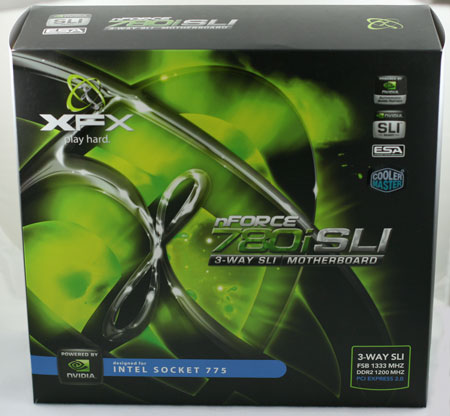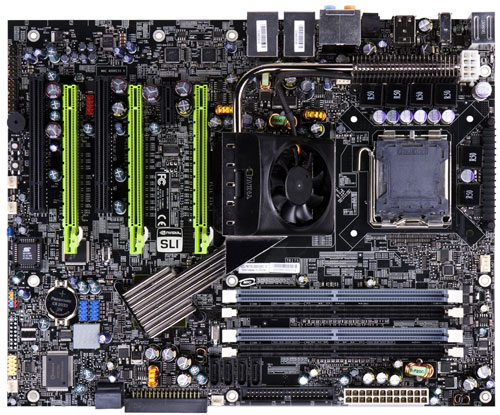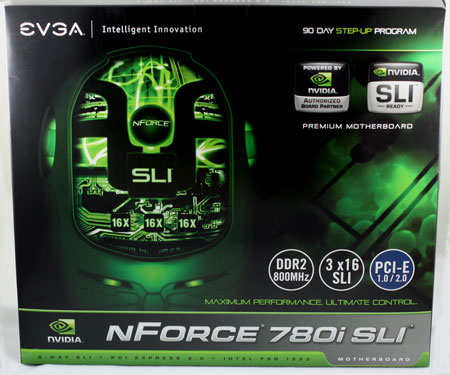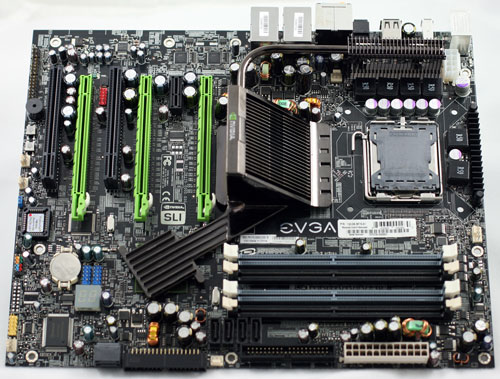NVIDIA 780i: Evolution Plus Triple SLI
by Wesley Fink on December 17, 2007 9:00 AM EST- Posted in
- CPUs
Launch Motherboards
At launch, two 780i motherboards are available from NVIDIA partners. As is often the case with new NVIDIA chipsets, both boards follow the NVIDIA reference board layout.

The XFX 780i will certainly stand out on a shelf. The package is almost twice the thickness of a normal motherboard.
 |
The motherboard itself is remarkably similar to the NVIDIA 680i, which should not come as a surprise to anyone.

Ports and port layout for the XFX 780i are the same as the earlier 680i reference board.

EVGA has also introduced a 780i motherboard. EVGA uses more standard motherboard packaging, with a very green NVIDIA theme.
 |
As you can see in the photo if would be difficult to tell the EVGA from the XFX board were it not for the EVGA logo.
Changes Compared to 680i
While the boards may look like 680i boards, there have been a few changes made to the reference design. We complained about the location of the front panel header, as did almost every site that reviewed the 680i. NVIDIA listened and they have now moved the front panel (power on, reset, LED, HD) connector block to a more traditional and easy to work with location.
NVIDIA also added a CPU thermal diode LED nest to the CPU fan pins. This turns red when the board detects abnormal CPU heat. This is not particularly useful once a board is in a case, but for test bench overclocking it is a nice feature. Windowed case users may also find it a useful addition.
Finally, NVIDIA has revised the heatpipe design to work better and keep the system a bit cooler. An optional fan is still included, and it is needed for serious overclocking. Those who value quiet can run the board without any active cooling at stock speeds.
Availability











23 Comments
View All Comments
Wesley Fink - Tuesday, December 18, 2007 - link
As mentioned in the article we also have a 780i overclocking review coming to answer your questions in more detail. This was a chipset launch, and there was little point of doing game tests when performance is the same as the well-tested 680i. The benchmarks we did run were just a sanity test to determine if 680i/780i really did perform the same, and they did.Anand is delving into Triple SLI performance and Gary Key will be doing an article on overclocking the 780i with Penryn. I will be following up later with an ESA system review, although the ESA test platform is actually is powered by a 680i.
All of these reviews were planned to work together, but got sidetracked in our server crisis and image meltdown. You should see Anand's Gaming/Triple SLI review tomorrow.
Frumious1 - Tuesday, December 18, 2007 - link
Since I don't have behind the scenes info, I'm left to conjecture. Maybe nVidia sent the hardware on Friday and you didn't have time, or maybe there were a bunch of testing issues. HardOCP seemed to be pretty unimpressed, but then what's new? Since this is a chipset launch article, with a few new features, I just felt we should see testing to check out how those features impact performance.SLI support, you've got SLI/Tri-SLI testing from Anand but that's with 8800 Ultra cards. It was a nice article, covering that area, but what about PCIe 2.0? Seems to be a part of the chipset, and some sanity checks with 8800GT SLI on both 680i and 780i would have been able to say if there was any actual difference. That wasn't done anywhere yet. That is not a motherboard review, or a Penryn overclocking article - that is a part of the chipset.
ESA is a system thing as I understand it, so it makes sense to wait for a complete system review. Overclocking is also somewhat part of a chipset review, but as demonstrated in teh past it's also very motherboard specific. Otherwise why is it that Asus, DFI, etc. do better than some others?
What it comes down to is that there appears to be one truly new and unique feature for 780i: PCIe 2.0 support. Well, and Penryn support, but that seems to be something that can be addressed on new 680i boards since 680i ~= 780i - nF200. You totally missed that in this "chipset launch review" by not even touching that with any form of benchmark. Show us some games, with PCIe 2.0 graphics cards, and show us whether there's any difference or not. That's what I want from an article looking at a new chipset - a focus on what's actually new.
Wesley Fink - Tuesday, December 18, 2007 - link
We said in the review that the current top PCIe 2.0 cards like the 8800 GT do not even come close to saturating the past PCIe 1.1 bus. Since PCIe 2.0 is just a bandwidth increase, and nothing else, why would you expect it to make any difference at all in the performance of the 8800 GT? That was alreay a known before the chipset review.Anand tested with the 8800 Ultra because the 8800 GT will NOT work in triple SLI. You must have a dual SLI connector for triple SLI, and the 8800GT doesn't have a dual connector. That is very well-explained in Anand's 3-way SLI article, and only the near obsolete 8800GTX and 8800Ultra have the dual connector.
Frankly we're always ready to test new technology, but the best I can figure the 780i SPP is a 680i SPP with the 16 lane PCIe connect overclocked to 4.5 GT/s. nVidia couldn't even quite reach the 5.0 GT/s level that is the PCIe 2.0 spec, but it really doesn't matter since PCIe 2.0 makes no difference today - it might in the future. The MCP is a 2-generations ago 570 MCP.
Changing an ID string and stamping a chip with a new name does not make it new technology. The chipset works well and will fill in for a short period until nVidia introduces their new chipset that will support 1600 FSB and DDR3.
Wesley Fink - Tuesday, December 18, 2007 - link
We said in the review that the current top PCIe 2.0 cards like the 8800 GT do not even come close to saturating the past PCIe 1.1 bus. Since PCIe 2.0 is just a bandwidth increase, and nothing else, why would you expect it to make any difference at all in the performance of the 8800 GT? That was alreay a known before the chipset review.Anand tested with the 8800 Ultra because the 8800 GT will NOT work in triple SLI. You must have a dual SLI connector for triple SLI, and the 8800GT doesn't have a dual connector. That is very well-explained in Anand's 3-way SLI article, and only the near obsolete 8800GTX and 8800Ultra have the dual connector.
Frankly we're always ready to test new technology, but the best I can figure the 780i SPP is a 680i SPP with the 16 lane PCIe connect overclocked to 4.5 GT/s. nVidia couldn't even quite reach the 5.0 GT/s level that is the PCIe 2.0 spec, but it really doesn't matter since PCIe 2.0 makes no differenc today - it might in the future. The MCP is a 2-generations agao 570 MCP.
Changing an ID string and stamping a chip with a new name does not make it new technology. The chipset works well and will fill in for a short period until nVidia introduces their new chipset that will support 1600 FSB and DDR3.
Frumious1 - Wednesday, December 19, 2007 - link
I understand why Anand used 8800 Ultra cards. That was the point of his article: Tri-SLI. Not chipset or anything else. And I'm guessing you're right that PCIe 2.0 is nothing and won't impact performance for probably years - in fact, I bet PCIe x8 is sufficient for everything we currently do, since ATI and nVidia use bridge connections for most card-to-card communications in SLI/CF. I'd still love to see an actual test that proves this is the case.You and I and everyone else can assume all we want, but without a test we don't actually KNOW. Since the only PCIe 2.0 cards are 8800GT (and the new GTS) and 3850/3870, and since this is an nVidia chipset, I just thought it would be good to prove and not guess at what impact PCIe 2.0 has. Maybe nVidia does benefit in some situations on SLI setups. Not likely, but maybe.
Frumious1 - Tuesday, December 18, 2007 - link
PS - if you don't have two 8800 GT cards floating around for PCIe 2.0 tests, you need to slap nVidia! Besides Penryn, that's the only feature worth testing on the new chipset.masteryoda34 - Monday, December 17, 2007 - link
This is probably the most disappointing recent motherboard launch from Nvidia. The only reason I could see buying this over an Intel P35 or X38 is for the SLI support. It's unfortunate they didn't use a new chipset. Basically the same as when they did NF4 to NF5, no new features just processor support.anandtech02148 - Monday, December 17, 2007 - link
with all these bulky graphic card pile up.. why dont' they just make a dongle connector for all the Sata ports.that or i need someone with sausage fingers that can reach all the sata ports.
and i guess the graphic guys realy want to rub out the audio cards.
Wesley Fink - Monday, December 17, 2007 - link
Actually the SATA ports are still accessible even with 3 double width graphics cards in Triple SLI. If you click to blow up the motherboard images on p.6 you will see the SATA ports are located so they fall just to the right of the first PCIe slot.You're right about audio though. Fortunately the on board is hi-def Azalia, but many will want a better audio card for 3-way SLI gaming.
customcoms - Monday, December 17, 2007 - link
Should be 650i, not 750i. Page 3.